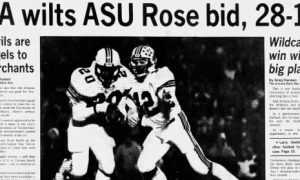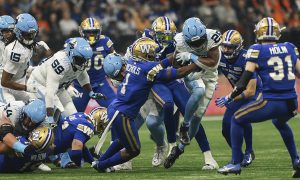[tps_title]NO. 28[/tps_title]
[tps_header]Collapse vs. Utah after leading 27-0 in fourth quarter changes face of program[/tps_header]
SCORE: Utah Utes 28, Arizona Wildcats 27
DATE: Nov. 4, 1972
SITE: Rice Stadium in Salt Lake City, 19,238 in attendance
WHY IT MADE THE LIST: Those old enough to remember the “Snafu of ’72” know how much of an impact the loss at Utah had on the Arizona football program historically.
The Wildcats led 27-0 after the start of the fourth quarter and they appeared headed to a 4-0 record in the Western Athletic Conference and probable appearance in the Fiesta Bowl. Embattled coach Bob Weber looked as though he could breathe easier after suffering through three consecutive losing seasons to start his UA career. The Cats were turning the corner — or so it seemed before they hit a dead end.
The Utes made an improbable comeback, scoring the go-ahead touchdown and extra point with 10 seconds remaining to defeat the shell-shocked Cats.
It stands as the greatest comeback by a UA opponent in the football program’s history.
“It’s something you can’t just forget for the rest of your life,” Weber told the Tucson Daily Citizen after the game.

Arizona’s 28-27 loss at Utah after leading 27-0 early in the fourth quarter derailed the Wildcats’ hope for a potential WAC title and altered the future of the program
Arizona president John Schaefer and athletic director Dave Strack were reportedly “giving out the ‘all right’ and ‘way to go’ with all the fervor of freshmen,” the Tucson Daily Citizen reported when the UA took a 27-0 lead into the fourth quarter. When the gun sounded and what was left of the 19,236 in attendance celebrated on the Utah side, Schaefer and Strack were immersed in a coaching-change controversy.
Had Arizona held on to beat the Utes — the Cats still led 27-14 with 4:30 remaining with possession at the Utah 36 — Weber would have likely kept his job because the Wildcats would have remained unbeaten in the WAC with three straight home games against BYU, Wyoming and ASU to end the regular season.
lthough the Utes had no timeouts left and the Cats faced a second-and-14, UA senior quarterback Bill Demory committed the snafu, by calling an audible for a pass instead of sticking to a fullback plunge to eat more clock. Demory’s pass was intercepted by a Utah defender, who returned it 68 yards for a touchdown to cut the lead to 27-21 with 4:19 to play.

After forcing the UA to punt with 2:20 left, the Utes drove 72 yards for the game-winning touchdown and extra point with 10 seconds left. Weber’s team was whistled for 16 penalties compared to four against the hometown Utes, but that was no excuse. Making matters worse for Schaefer and Strack: Former UA coach Jim LaRue, who was fired in 1966 after consecutive three-win seasons, was Utah’s defensive coordinator. After the collapse, Arizona lost two of its last three games to finish 4-7 and Weber was let go.
Jim Young, a promising Bo Schembechler assistant at Michigan, was hired and he immediately coached Arizona (with many Weber holdovers) to three consecutive records of 8-3, 9-2 and 9-2 from 1973-75. Because of this run, the UA believed it could competitively make the jump to the Pac-8. The Young era, which probably would not have happened if Arizona beat Utah in 1972, was crucial to Arizona advancing its athletic program beyond the WAC at that time.
Young left to Purdue after the 1976 season. The following year, Arizona accepted a move to the Pac-8 and the Wildcats competed in the Pac-10 starting in 1978.
In hindsight, was the record comeback by Utah in 1972 beneficial or detrimental to the development of the Wildcat program? Weber, bless his soul, tried all he could to get Arizona to the 1972 Fiesta Bowl. Many of the players he recruited helped Young be successful and direct the UA toward the Pac-10.
The turn of events in that landmark 1972 game ironically gave the Cats the momentum they may have needed for greener pastures. Weber knew all about the ramifications of momentum.
“I don’t want to bore you guys with the word, but ‘Momentum’ is a word that I’ve learned to really spell,” Weber told reporters a day after the collapse against Utah.

Arizona started to turn the corner and become more competitive against ASU in the 1970s under Jim Young (YouTube video capture)
The Wildcats finished 6-1 in the WAC in 1974, one-half game behind BYU, which beat the Wildcats 37-13 earlier that season in Tucson. ASU finished 6-5 and 4-3.
“Our offense was disappointing but credit a lot of that to a good U of A defense,” Kush said in the AP article.
Freshman place-kicker Lee Pistor made a 36-yard field goal with 5:51 remaining in the fourth quarter and running back Willie Hamilton scored a touchdown on a 4-yard run with 32 seconds left for the Wildcats.
Arizona’s Mitch Hoopes, a Bisbee native who later played for the Dallas Cowboys in Super Bowl X, punted 11 times for an average of 45 yards per kick. ASU punted 10 times in the defensive struggle.
With less than two minutes remaining, Kush was forced to go for a first down on a fourth-and-3 situation at the ASU 36. The Wildcat defense stuffed the attempt. Arizona quarterback Bruce Hill led the Wildcats from there for the UA’s lone touchdown. The drive was aided by a personal-foul penalty on the Sun Devils.
The Wildcats defense included All-WAC selections Mike Dawson at tackle, Mark Jacobs at linebacker and Dennis Anderson at safety. Obra Erby, an All-WAC pick the following year, was a junior linebacker in 1974. An interception by Jacobs off a Dennis Sproul pass at the ASU 35, set up Pistor’s go-ahead field goal.




























